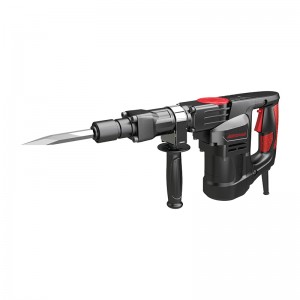In engineering scenarios such as construction and renovation, the electric hammer, as a core drilling tool, its performance directly affects the progress and quality of the operation. Hexagonal electric hammers and SDS-plus electric hammers are two common types in the market. Although they seem to have similar functions, in fact, there are significant differences in design principles, applicable scenarios and drilling efficiency. For international wholesale purchasers, a thorough understanding of their characteristics can not only provide customers with precise product selection suggestions, but also enhance their own say in the professional field. Next, we will conduct this “ultimate showdown of drilling efficiency” from multiple dimensions.
First, structural design: The difference in principles determines the foundation of efficiency
The hexagonal electric hammer adopts the traditional hexagonal interface design and connects the drill bit to the machine body through a simple slot. The advantage of this structure lies in its convenient disassembly and assembly. The drill bit can be quickly replaced by hand, making it suitable for operation scenarios where different types of drill bits are frequently switched. However, due to the relatively simple fixing method of the hexagonal interface, the drill bit is prone to slight loosening during high-frequency impact and rotation operations, resulting in a decrease in drilling accuracy. Especially during long-term and high-intensity operations, this shaking will affect the drilling efficiency and may even damage the drill bit or the workpiece.
The SDS-plus (also known as the four-pit system) adopts a unique four-pit slot design. After the drill bit is inserted, it closely engages with the drive pins inside the machine body through four slots. This structure can achieve efficient coordination of “rotation + impact” and has almost no loss when transmitting power. When the SDS-plus electric hammer is in operation, the drill bit can not only rotate at high speed for cutting, but also break hard materials with a stronger and more precise impact force. In contrast, its structural design fundamentally reduces energy loss, laying the foundation for efficient drilling.
Second, applicable materials: Different specialties affect work efficiency
Material properties are the key factors determining the efficiency of electric hammer drilling. Hexagonal electric hammers, due to their power transmission characteristics, are more suitable for working on relatively soft materials such as wood, gypsum board, and thin metal. On this type of material, hexagonal electric hammers can quickly position and precisely drill holes. Moreover, due to the low resistance of the material, the problem of drill bit loosening is less likely to occur. However, when dealing with hard materials such as concrete and stone, the impact force and stability of the hexagonal electric hammer are insufficient, the drilling speed drops significantly, and it may even cause motor damage due to overheating.
The SDS-plus electric hammer is an “expert” in drilling hard materials. Its powerful impact force and stable power transmission make it perform well in the construction of concrete walls, granite floors, etc. Through high-frequency and high-intensity impacts, the SDS-plus electric hammer can quickly break hard materials. Combined with rotary cutting, it significantly improves the drilling efficiency. Whether it is drilling holes in load-bearing walls in construction projects or opening holes in stone materials in decoration projects, the SDS-plus electric hammer can complete the tasks at a faster speed and with higher precision.
Third, operational experience: Detailed design affects continuous efficiency
In actual construction, the ease and comfort of operation of the electric hammer will directly affect the continuous working efficiency of workers. Hexagonal electric hammers are usually small in size and light in weight. For short-term and small-scale drilling tasks, workers can operate them easily, reducing physical exertion. However, when it operates for a long time at high intensity, due to the obvious vibration transmission, it is prone to cause hand fatigue, which indirectly affects the drilling efficiency and accuracy.
Although the SDS-plus electric hammer has a relatively large overall weight, it is more outstanding in shock absorption design. Many SDS-plus electric hammers are equipped with advanced shock absorption systems. Through special mechanical structures or rubber buffer components, the transmission of vibrations to the hand is effectively reduced. This enables workers to maintain a good sense of grip and control even during long-term operations, ensuring continuous and efficient work. In addition, the functions such as the depth limiter and rotation Angle lock of the SDS-plus electric hammer can also help workers complete the drilling tasks more accurately and efficiently in complex construction.
Fourth, maintenance and care: The guarantee of service life affects the overall efficiency
The durability of tools and the convenience of maintenance also affect the overall operational efficiency. The hexagonal electric hammer has a relatively simple structure, with low daily maintenance costs. It is also relatively easy to replace the drill bit and troubleshoot. However, due to the limitations of its interface design, interface wear after long-term use may lead to a decrease in drilling efficiency, and components need to be replaced regularly.
Although the internal structure of the SDS-plus electric hammer is complex, thanks to its sturdy four-pit system and high-quality materials, its service life is longer under normal use. However, its maintenance is relatively professional. For instance, operations such as cleaning the accumulated dust inside and replacing the impact piston require certain technical knowledge and tools. But in the long run, stable performance and a longer service life make it more advantageous in terms of overall efficiency.
Hexagonal electric hammers and SDS-plus electric hammers each have their own merits. There is no absolute “king of efficiency”, only more suitable application scenarios. For international wholesale purchasers, a thorough understanding of the differences between the two and recommending products based on the actual needs of customers can not only enhance customer satisfaction but also establish a professional and reliable brand image. Whether it is a small-scale decoration project or a large-scale construction project, choosing the right tools can make drilling operations twice as effective with half the effort.
Post time: Jun-24-2025

